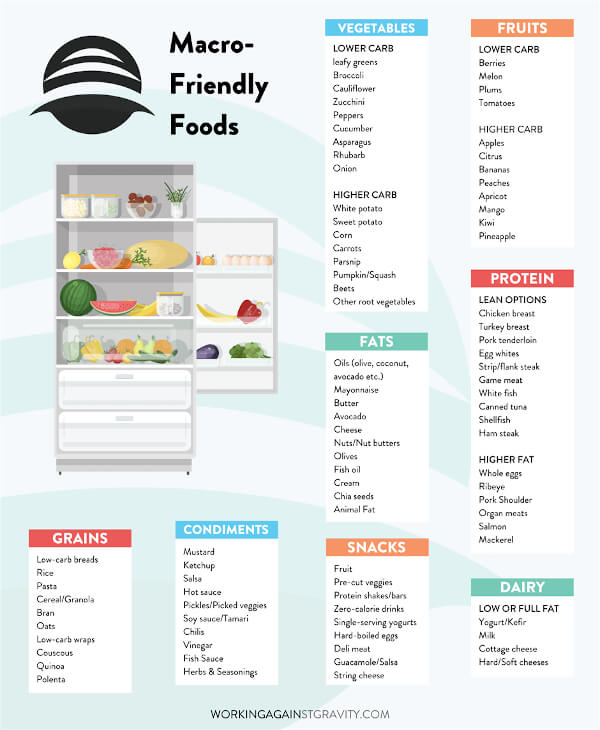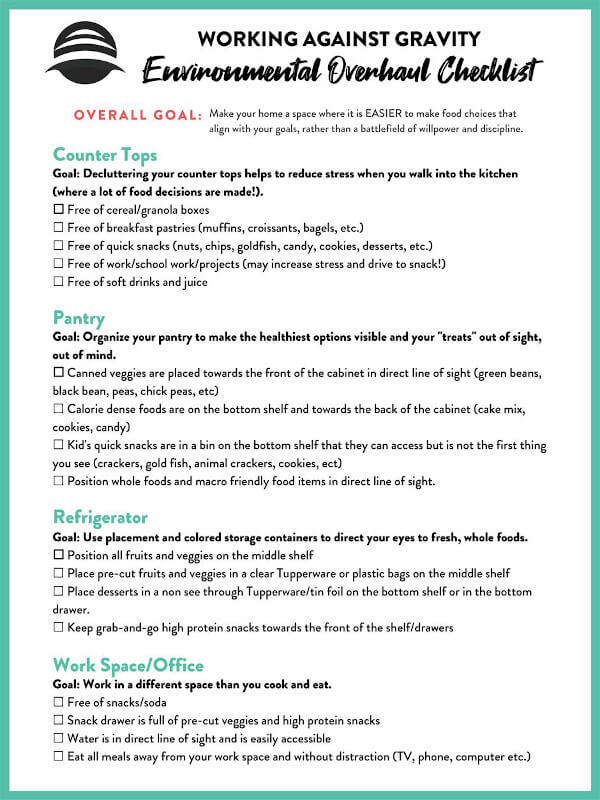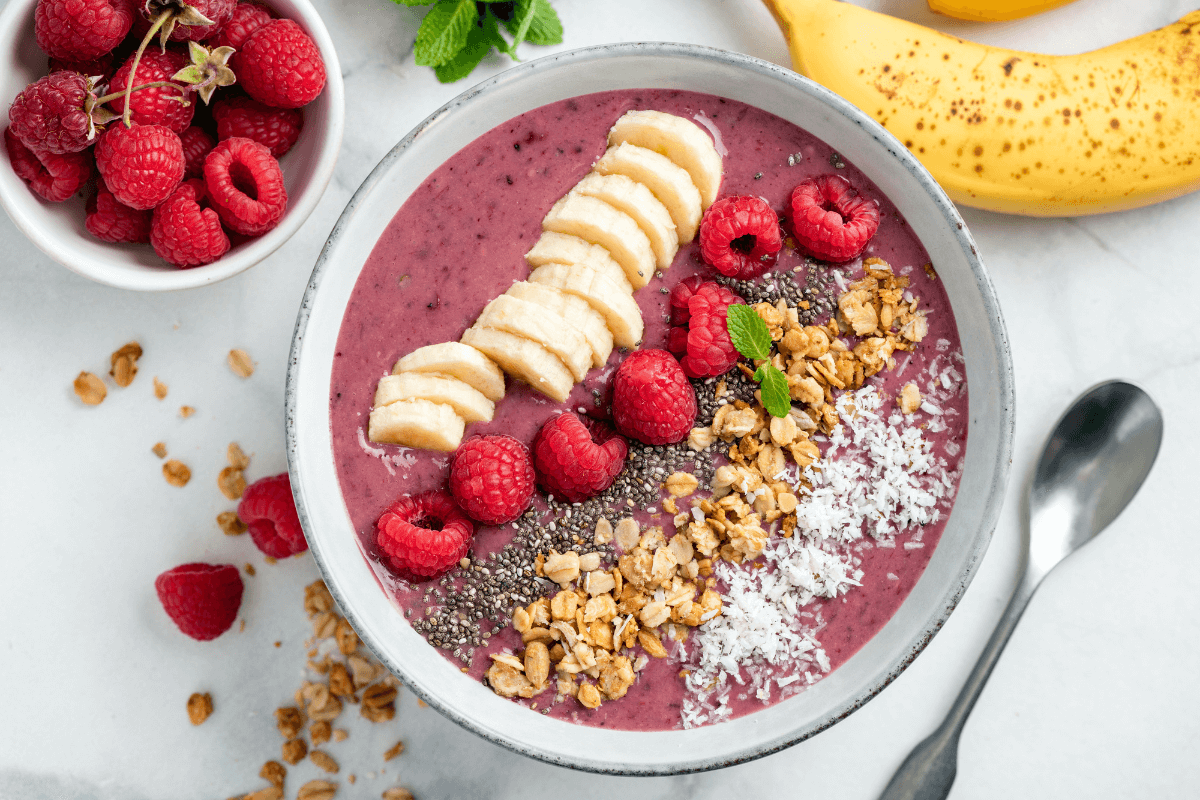
Can you relate to this scenario?
It’s a Tuesday and you’re stuck working from home (thanks to COVID-19). You’re feeling a little hungry, so you wander into the kitchen and open the fridge.
This is your 6th trip to the kitchen today – and it’s only 10 AM! This pandemic is really not helping you achieve your nutrition and fitness goals, is it?
Don’t worry, we can help!
In today’s blog, we’re talking about why focusing on the optimal food environment will help you achieve your nutrition and fitness goals – even while stuck at home!
Advertisement
It can be challenging and take quite a long time to alter deep-seated habits around food, but it’s simple and quick to change your environment.
We’ll show you how!
How your food environment helps you reach your goals
First let’s start by discussing why your food environment is so important.
Most people think that the most important aspects of achieving nutrition and health goals include things like: having a plan, being disciplined, staying motivated, etc. And of course, those things are important.
Advertisement
But before we even get to those things, we’re going to face temptations from our food environment.
We bet you can think of a time in recent history where you felt more stressed than usual and noticed the urge to self-soothe using food. That ice cream in the freezer looks extra delicious after a tough day of work or an argument with a loved one, right?
That is exactly why it’s so important to set up your food environment for success. Controlling our environment makes decisions easier so we do not have to rely on willpower.
Willpower is a muscle and it will get fatigued as we make choices throughout the day (especially if we are experiencing a lot of stress – and, let’s be honest, most of us are more stressed than usual during this pandemic!).
We face a lot of food-related choices each day, probably without even realizing it. For example:
Advertisement
- Should we make oatmeal or have cereal for breakfast?
- Should we eat the rest of the food off our kid’s plate or throw it away?
- Should we make dinner at home tonight or order takeout to support that local restaurant?
If we’ve set up our kitchen, pantry, and fridge so that it’s easier to resist temptation, chances are much higher we’ll be able to stick to your nutrition goals – even while experiencing stress.
Below are five action steps to make our food environment work for us.
Step 1: Determine whether you’re an abstainer or moderator.
During this pandemic, most of us are spending a lot of time at home. This means it’s more important than ever to be honest with ourselves about which foods we can safely keep in the house – and which foods are better left on supermarket shelves.
In other words, we want to determine if we’re an “abstainer” or a “moderator” with our nutrition.
You’re likely a moderator if you:
Advertisement
- Find that occasional indulgence heightens your pleasure – and strengthens your commitment to stay on track
- Panic at the thought of “never” getting or doing something
You’re likely an abstainer if you:
- Have trouble stopping eating something once you’ve started (chips, peanut butter, candy, etc.)
- Aren’t tempted by things that you’ve decided are officially off-limits
There’s no right or wrong way – it’s just a matter of knowing which strategy works better for us. If moderators try to abstain, they feel trapped and rebellious. If abstainers try to moderate, they spend a lot of precious energy justifying why they should go ahead and indulge.
So, right now, being stuck at home with a higher level of stress than usual, which category do you think you fit into? (Note: sometimes the determination of whether we’re an abstainer or moderator depends on the specific food at hand).
Here’s an example: maybe you’re not usually tempted by that bag of chocolate chips in the pantry, but with the additional stress around COVID-19, you find yourself mindlessly grabbing a handful a few times each day.
In this situation, it may be best to shift toward “abstainer” behaviors. For right now, it may be wise to throw the chocolate chips away or store them on a very high shelf you can’t easily reach.
Advertisement
On the other hand, maybe you find that giving yourself permission to enjoy a few chocolate chips each day actually helps you feel satisfied and content with your veggies and protein during the rest of the day.
Again, no right or wrong answers here – it’s all about being honest with ourselves.
Step 2: Head into the kitchen and move tempting foods out of eyesight.
The motto of this section is: we eat what we see, not what we don’t.
Now that we’ve determined whether we’re moderators or abstainers, it’s time to check out our kitchen.
Start by examining the counters. Are there tempting treats sitting where they’re easily visible? If we have to walk past those treats a dozen times each day, we will be forced to constantly flex (and quickly fatigue) our ‘willpower muscle’.
Advertisement
We recommend moving the treats out of eyesight. (And once you’ve removed them, try replacing them with a bowl of fruit!).
Next, open your fridge. Which foods do you see first? Do those foods fit within your nutrition plan? Or do you immediately see the foods that you struggle to eat in moderation?
The goal is to make the healthiest choice also be the easiest choice. Our eyes are naturally drawn to foods at eye level in the fridge. Take advantage of that by putting fruits and vegetables there.
While we’re looking in the fridge, what kind of containers do you see? Try putting the tempting or non-macro-friendly foods in opaque containers and the more-macro-friendly foods in clear ones.
Now let’s check out your pantry and cabinets. The same tips we recommended for your fridge apply here. What do you immediately see when you open the pantry? Make the first foods you see the ones that fit well into your nutrition plan.
Advertisement
If you have kids, try setting up a designated “kids’ cupboard” that’s off-limits to you. Make it somewhere that requires time and effort to access – which gives you time and space to think before grabbing your kids' treat.
Step 3: Make sure your kitchen is stocked well.
Now that you’ve set up your kitchen for success, it’s time to tackle your next grocery trip.
The goal at the grocery store is to focus on selecting foods that fit within your nutrition plan and leaving behind the foods you know you’ll struggle to enjoy in moderation.
On your grocery list, make sure to include lots of protein sources, as well as fruits and vegetables (if the grocery store supply is running low on fresh produce, remember that frozen is great, too!).
Check out this infographic with tons of macro-friendly foods in every category (you may want to save this image on your phone to reference later!):
Advertisement

Step 4: Use these tips to keep portion sizes under control.
Now that you’ve stocked up on nutrient-dense food, we’re ready to talk about portioning it out.
Start with your dishes. If we use large plates and bowls, we’re likely to fill them up with food. Using smaller dishes will lead to automatic portion control.
When you went grocery shopping, did you buy in bulk? It can definitely be cost-effective to do that (from places like Sam’s Club and Costco), but having huge containers of food can also make it more tempting to reach into them and grab handfuls. This can cause us to lose track of portion sizes. So, when you shop in bulk, repackage the huge portions into single servings (try using single-serve baggies).
Step 5: Make meal prep more fun.
We all know that meal prep makes it easier to follow our nutrition program. But not everybody loves the meal prep process. So, we have tips that can make the experience more efficient and enjoyable!
Advertisement
- Play music or a podcast on a speaker in your kitchen (or grab some headphones
- Ask for some help from a spouse, roommate or child
- Purchase high-quality Tupperware (glass containers tend to last the longest!)
- Purchase a high-quality knife to speed up chopping
- Make sure your meal prep space is clutter-free
Those are all our tips for setting up your environment for success! If you enjoyed them, we know you’ll want to download the Environmental Overhaul Guide! It’s a downloadable checklist to ensure your environment is set up for success.

By using the tips above, it will be much easier to stick to your nutrition plan – even during a pandemic! But if you could use a little extra nutrition support and guidance, check out the Working Against Gravity 1-on-1 nutrition coaching program. Your coach is ready to work with your unique preferences and lifestyle to create the perfect customized nutrition program that you can sustain for life.
Schedule a Free Intro Call
Working Against Gravity has led the macro tracking and health space for over a decade. Our team doesn’t just understand the science of nutrition—we’ve spent years mastering the art of tailoring it to fit your life. That means no cookie-cutter plans, just real strategies that have worked for over 30,000 people.
Schedule a free call with our team to learn how working with a 1-on-1 WAG coach will help you reach your goals.



